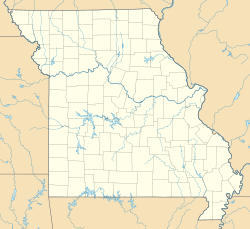Free Will Baptist Church of Pennytown facts for kids
Quick facts for kids |
|
|
Free Will Baptist Church of Pennytown
|
|
| Nearest city | Marshall, Missouri |
|---|---|
| Area | 0.5 acres (0.20 ha) |
| Built | 1925 |
| Built by | Percy Watson, Will McCue, Richard Lewis, Mike Molden, et al. |
| NRHP reference No. | 88000388 |
| Added to NRHP | April 19, 1988 |
The Free Will Baptist Church of Pennytown is a very old and important church for African-American history. It is located in Pennytown, a small community in Saline County, Missouri. This special church was built in 1925. Because of its history, it was added to the National Register of Historic Places in 1988. This means it is a place that is officially recognized as important to the history of the United States.
Contents
Discovering Pennytown
A Special Town is Born
Today, the Free Will Baptist Church is almost all that is left of Pennytown. Pennytown was a small village started by people who had been slaves but were now free. It was founded around 1871 by a man named Joseph Penny. He was a former slave who moved to Saline County, Missouri from Kentucky after the American Civil War.
Joseph Penny used all his savings to buy eight acres of land. He wanted this land to be a safe place for other recently freed slaves to start new lives. He divided the land into smaller pieces and sold them at prices people could afford. Other freed slaves also bought land nearby. By 1879, the community had grown to about forty families and covered sixty-four acres.
Life in Pennytown
By 1880, about 200 African-Americans lived in Pennytown. They had a school, two churches, a blacksmith shop, and other businesses. Unlike some other towns started by freed slaves, Pennytown was mostly safe from people trying to trick them out of their land. This was because Joseph Penny made sure everyone had clear legal papers for their property.
Because they owned their land, people in Pennytown did not have to become sharecroppers. Sharecropping was a system where farmers worked on land they didn't own and often ended up in debt. Instead, the men of Pennytown earned money by working on farms nearby or in the town of Marshall. The women also worked, often helping in homes. When the adults were at work, older people in Pennytown helped take care of the children.
Why Pennytown Changed
Pennytown started to lose people in the 1920s. This happened because farms began using machines, so they didn't need as many workers. The Great Depression in the 1930s made things even harder, as there were fewer jobs. The last family moved away from Pennytown in 1943. Only a few older residents stayed until they passed away.
The Church's Story
Building a Place of Worship
In 1886, a white neighbor gave a half-acre of land for the community to build a church. Before this, church services were held in people's homes or outside under brush shelters. A simple church made of wood was built on this spot. However, it was destroyed by fire in 1924.
The community decided to build a new church. The current church, made of tile blocks, was built between 1925 and 1926. The church members didn't have enough money to buy all the building materials at once. So, over several months, they bought a few tile blocks whenever they had enough money. They stacked the blocks at the building site. Finally, in the fall of 1925, the foundation was laid. Most of the building work was done by the men of the community and the church members themselves. At first, a large lamp provided light inside the church. Later, kerosene lamps were added to the walls.
Saving the Church Building
As the village of Pennytown became smaller in the mid-1900s, the church building also started to fall apart. By the 1980s, the church was in very bad condition. People had broken the windows, and the weather had badly damaged the roof and foundation.
Even though it was in poor shape, the church was added to the National Register of Historic Places in 1988. This was largely thanks to the hard work of Josephine Robinson Lawrence, a historian who used to live in Pennytown. Money for repairs was raised from people all over the U.S. They sold Pennytown cookbooks, held raffles, and had bake sales. By 1994, they had collected $18,000. This money helped them get a special grant from the Missouri Department of Natural Resources in 1995.
By 1996, most of the restoration work was finished. A new foundation was built, new windows and doors were put in, the original tile blocks were fixed, and a new roof was added. The inside of the church was also made new with paint, drywall, and a new wood floor.
The Church Today
Today, a group of volunteers called the Friends of Pennytown Historic Site takes care of the church building. Every year, on the first weekend of August, former residents and their families come back for a reunion called Homecoming. This tradition started after World War II because people who had moved away wanted to stay connected to their roots.
Next to the church, there is a natural pond. This pond was used for baptisms when the church was active. A large sign on a pole near the church explains the history of the community and the church.



